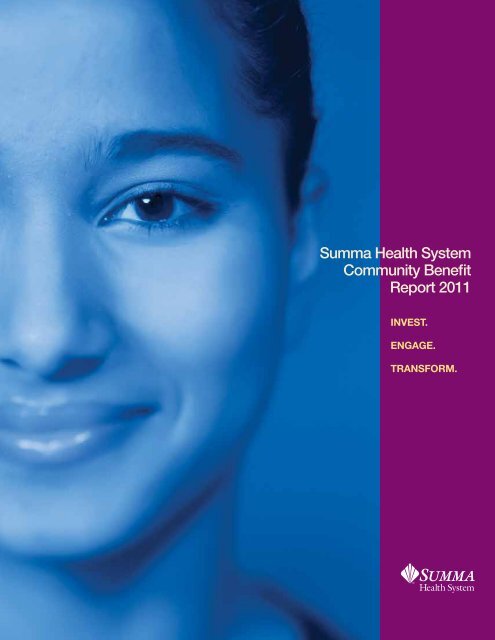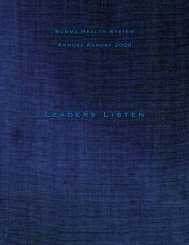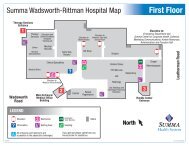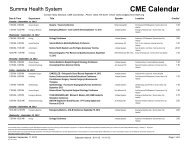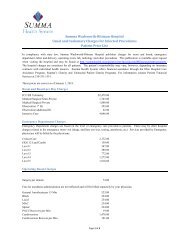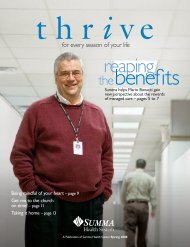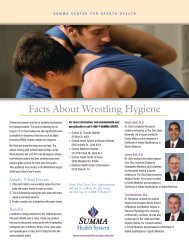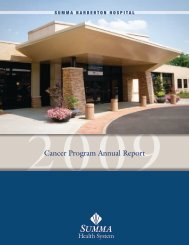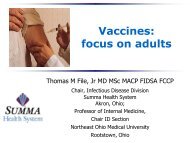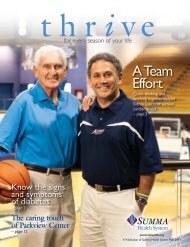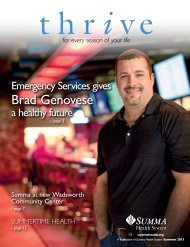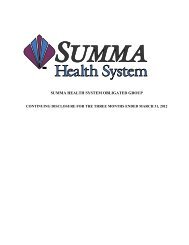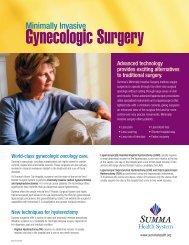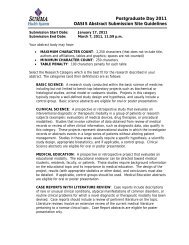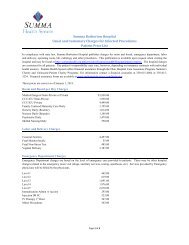Community Benefit Report - Summa Foundation
Community Benefit Report - Summa Foundation
Community Benefit Report - Summa Foundation
Create successful ePaper yourself
Turn your PDF publications into a flip-book with our unique Google optimized e-Paper software.
<strong>Summa</strong> Health System<br />
<strong>Community</strong> <strong>Benefit</strong><br />
<strong>Report</strong> 2011<br />
INVEST.<br />
ENGAGE.<br />
TRANSFORM.
WELCOME TO<br />
SUMMA HEALTH<br />
SYSTEM’S 2011<br />
COMMUNITY<br />
BENEFIT REPORT<br />
<strong>Summa</strong> Health System’s mission is to<br />
provide the highest quality, compassionate<br />
care to our patients and members and to<br />
contribute to a healthier community. The<br />
members of our community are at the core<br />
of our mission and drive everything we<br />
do. Our <strong>Community</strong> <strong>Benefit</strong> and Diversity<br />
department assists in fulfilling our mission<br />
by designing, implementing and evaluating<br />
numerous programs and activities which<br />
are directed toward providing treatment<br />
or promoting health and healing as a<br />
response to identified needs. Through this<br />
work and in countless other areas, <strong>Summa</strong><br />
is committed to investing, engaging and<br />
transforming our community.
At <strong>Summa</strong>, we believe we have an obligation<br />
to hold ourselves to high standards as we<br />
engage and support our community in<br />
fulfilling our mission, yet know we cannot<br />
accomplish this task alone. In the stories<br />
in this report, we share with you the efforts<br />
we have taken to begin to eliminate health<br />
disparities in the community. We explain how<br />
our employee volunteers provide services<br />
that revitalize our surrounding area. We<br />
demonstrate the steps we have taken to<br />
begin to recognize and understand the vast<br />
diversity of cultures within our community and<br />
how this knowledge has improved the care<br />
we deliver to all of our patients. Finally, we<br />
illustrate how building collaborations between<br />
our system and our community partners<br />
advances the goals of all partners involved.<br />
The stories in this report illustrate only a small<br />
portion of the impact we make in the greater<br />
Akron region. By providing support for health<br />
improvement activities, financial and in-kind<br />
donations and community-building activities,<br />
<strong>Summa</strong> assists our partner organizations<br />
in fulfilling their goals as well as our own. In<br />
addition, our robust research and education<br />
initiatives demonstrate our investment in<br />
finding solutions to transform the health<br />
status of the community and in training<br />
our future healthcare workforce.<br />
In 2011, <strong>Summa</strong> contributed more than<br />
$106.7 million in community benefit, an<br />
increase of 3.1% over our contributions in<br />
2010. Although this report provides a specific<br />
dollar amount, the true impact of our work<br />
is immeasurable. We remain committed<br />
to investing, engaging and transforming<br />
our community now and in the future and<br />
continue to strive to be recognized as<br />
one of the finest healthcare organizations<br />
in the nation.<br />
Thomas J. Strauss,<br />
<strong>Summa</strong> Health System president and<br />
chief executive officer<br />
Roxia Boykin, MPA, RN, <strong>Summa</strong> Health<br />
System vice president,<br />
community benefit and diversity<br />
Margaret Ralston Payne, MA, chair,<br />
<strong>Summa</strong> Health System<br />
<strong>Community</strong> <strong>Benefit</strong> Committee<br />
Pg 1
<strong>Summa</strong> Health System <strong>Community</strong> <strong>Benefit</strong> <strong>Report</strong> 2011<br />
Janice Davis
FINDING SOLUTIONS FOR HEALTH DISPARITIES<br />
<strong>Summa</strong> Health System is committed to managing the<br />
health of the populations we serve. Unfortunately, many<br />
barriers exist for patients to achieve optimal health,<br />
including health disparities.<br />
Health disparities are preventable differences in disease<br />
that impede optimal health and can be related to gender,<br />
race or ethnicity, income, education, generation, sexual<br />
orientation or geography. In an effort to address health<br />
disparities and ultimately transform the community,<br />
<strong>Summa</strong> has developed programming to improve<br />
access, quality and outcomes for its patients.<br />
In 2011, construction was completed at the Village at<br />
New Seasons, an $11.4 million complex with retail space<br />
and affordable senior housing in West Akron. <strong>Summa</strong>’s<br />
Center for Health Equity is its anchor tenant, and offers<br />
a new approach to providing care by bringing it directly<br />
to the community and enabling people to take an active<br />
role in their health.<br />
Janice Davis, MBA, is a resident of the Village at New<br />
Seasons and a life-long resident of Akron. She watched<br />
this complex develop and is excited about the access it<br />
provides the community.<br />
“The Center for Health Equity means a great deal to<br />
the community,” she shared. “<strong>Summa</strong> is making<br />
strides in senior outreach, diabetes education, healthy<br />
eating tips and more. I think it is great mental health<br />
exams are integrated into routine medical care. When<br />
you have a healthy mind, your view of your whole life<br />
changes; this is a critical factor to successfully bridging<br />
the health gap.”<br />
<strong>Summa</strong> developed programming to address the<br />
largest concerns in the community, which included<br />
obesity, diabetes and cardiovascular risk factors, all of<br />
which were confirmed by the community assessment<br />
conducted in 2010, as well as state and national<br />
surveys. The goal of this<br />
programming is to produce<br />
better outcomes and<br />
healthier lives.<br />
<strong>Summa</strong> recognizes that health disparities affect<br />
everyone. “If one population has poor health outcomes,<br />
it affects the entire community,” said E. Demond<br />
Scott, M.D., MPH, executive director for health equity<br />
for <strong>Summa</strong> Health System and whose visionary<br />
leadership has helped to create <strong>Summa</strong>’s Center for<br />
Health Equity. With a vision of “healthy people living<br />
in healthy communities,” the Center collaborates with<br />
patients, community residents and community-based<br />
organizations to address social and behavioral factors<br />
influencing health in order to fulfill its mission to eliminate<br />
health disparities in our community. “For example, poorly<br />
controlled chronic diseases can lead to poor outcomes,<br />
possibly even loss of life for the head of a household.<br />
This loss of life and/or income could have a negative<br />
economic, social or developmental impact on the<br />
surviving family members or lead to loss of productivity<br />
“Studies have shown that for every one dollar spent<br />
on proven community-based prevention programs,<br />
nearly six dollars are returned.”<br />
within the community at large, potentially affecting<br />
the next generation. There’s a domino effect in play,”<br />
explained Scott.<br />
Between the years 2003-2006, 30 percent of<br />
adult medical care costs for African-American,<br />
Asian and Hispanic patients was due to excess<br />
costs related to health inequities. Eliminating<br />
differences in health status and healthcare access<br />
for minorities could result in as much as a $230 billion<br />
savings in medical care expenditures according to<br />
one study. This staggering number has an effect on<br />
every community, including Akron.<br />
The journey to eliminate health disparities is a long<br />
one, but <strong>Summa</strong> is committed to its path. “The<br />
transformation for <strong>Summa</strong> involves education for<br />
healthcare professionals, patients and the community<br />
at large. It’s a cultural transformation that will be<br />
worthwhile in the long run,” shared Scott. “Studies<br />
have shown that for every one dollar spent on proven<br />
community-based prevention<br />
programs, nearly six dollars are<br />
returned. That’s where our<br />
focus is.”<br />
Pg 3
<strong>Summa</strong> Health System <strong>Community</strong> <strong>Benefit</strong> <strong>Report</strong> 2011<br />
Chris Davis
IMPROVING THE COMMUNITY THROUGH VOLUNTEERISM<br />
One of <strong>Summa</strong> Health System’s core values is community<br />
service. The Employee Volunteer Program (EVP) engages<br />
<strong>Summa</strong> employees and their families in volunteer service<br />
throughout our region. <strong>Summa</strong> offers opportunities for<br />
employees to strengthen their commitment to the<br />
communities where they live and work.<br />
The benefits of <strong>Summa</strong> Health System’s EVP are many,<br />
touching employees, the organization and ultimately,<br />
the community. This service builds teamwork and<br />
leadership skills for employees. <strong>Summa</strong> strengthens<br />
trust and loyalty among community members and<br />
engages them. Finally, volunteers provide a skilled and<br />
talented volunteer pool, offer direct cost savings for<br />
organizations, create quantifiable social impact and<br />
help bring organizations’ needs into focus.<br />
biodiversity in the Cuyahoga Valley watershed<br />
by removing trash and invasive plants such as<br />
Japanese Knotweed.<br />
“The whole food web can be destroyed by invasive<br />
plants,” explained Chris Davis, plant biologist with<br />
Cuyahoga Valley National Park. “It is impossible to<br />
combat these exotic plants with just the park staff.<br />
We count on volunteers to help us restore a healthy,<br />
functional ecosystem again. The work we have<br />
completed has allowed thousands of native plants<br />
to begin growing again.”<br />
In addition, <strong>Summa</strong> had two service projects in 2011<br />
at the Akron Zoo: World Ocean’s Day and Boo at the<br />
Zoo. World Ocean’s Day is held in June of each year<br />
to celebrate a vital part of the ecosystem– the ocean.<br />
“We count on volunteers to help us<br />
restore a healthy, functional ecosystem again.”<br />
Through <strong>Summa</strong>’s EVP, employees and their families<br />
and friends may volunteer to participate in group or<br />
department service opportunities such as volunteering<br />
as a team to serve lunch at a local homeless shelter,<br />
ship care packages to our U.S. troops overseas with<br />
the United Service Organization of Northern Ohio or<br />
volunteer for Habitat for Humanity. Employees can also<br />
participate in recurring service opportunities such as<br />
volunteering for AkronReads, a tutoring program that<br />
pairs up a <strong>Summa</strong> employee and a 3rd grade student<br />
to work on his/her reading. <strong>Summa</strong> also assists<br />
employees in finding board opportunities that are of<br />
interest to them and in filling board positions upon<br />
request from non-profit agencies.<br />
In 2011, Cuyahoga Valley National Park (CVNP) and<br />
the Conservancy for Cuyahoga Valley National Park<br />
sought energetic volunteers to help clean up<br />
the Cuyahoga River watershed in<br />
celebration of the 21st Annual<br />
RiverDay on Saturday, May 21.<br />
Volunteers helped conserve<br />
Boo at the Zoo in October is an important annual<br />
fundraiser. It enables zoo visitors to enjoy festive<br />
decorations and lighted displays throughout the zoo,<br />
all while trick-or-treating at 12 different themed stations.<br />
<strong>Summa</strong> volunteers dressed up as different characters<br />
and interacted with children, helping to build their<br />
imagination and sense of creativity.<br />
<strong>Summa</strong> assumes the responsibility to be a good<br />
corporate citizen towards the community and<br />
environment and was recently recognized by two<br />
organizations. Northcoast 99 awarded <strong>Summa</strong> a special<br />
Corporate Social Responsibility Award which recognized<br />
<strong>Summa</strong>’s unique and innovative approach to this work.<br />
The inaugural Pinnacle Awards of Summit County,<br />
sponsored by Inside Business, in partnership with<br />
the United Way of Summit County, selected <strong>Summa</strong><br />
as a recipient based on our practice of<br />
corporate social responsibility and<br />
our continuing commitment to<br />
improve the quality of life of<br />
the local community.<br />
Pg 5
<strong>Summa</strong> Health System <strong>Community</strong> <strong>Benefit</strong> <strong>Report</strong> 2011<br />
Nirmala Ghimirey
ESTABLISHING A NEW LIFE IN AKRON<br />
Contributing to the diversity you find in the Akron<br />
community is our growing refugee population.<br />
Because Akron serves as a federal refugee relocation<br />
center, Summit County has welcomed more than<br />
1,100 refugees since 2006. According to statistics<br />
from the Ohio Department of Job and Family<br />
Services, most of these refugees are from camps<br />
outside of Bhutan and Myanmar.<br />
<strong>Summa</strong> Health System has a true appreciation<br />
for Akron’s diversity. The Family Medicine Center<br />
at <strong>Summa</strong> Akron City Hospital currently provides<br />
healthcare for 800 refugee patients. This influx of<br />
refugee patients has provided <strong>Summa</strong> the opportunity<br />
to change the model of care to meet the needs of<br />
this widely diverse population.<br />
I have shadowed both an anesthesiologist and<br />
pathologist at <strong>Summa</strong>. These experiences have helped<br />
me decide my major in college.”<br />
Ghimirey graduated at the top of her class with a 4.013<br />
grade-point average and was named one of the 2012<br />
class valedictorians at Akron’s North High School; she<br />
will major in biology in the fall at Kent State University.<br />
To help families like the Ghimireys, the Family Medicine<br />
Center has responded to the refugee population’s health<br />
needs in a number of ways. Language barriers are key<br />
issues in healthcare delivery. <strong>Summa</strong> employs a multilingual<br />
physician, works with various language interpreting<br />
services and provides office appointments of greater<br />
length to assist refugee patients. In 2011, <strong>Summa</strong> spent<br />
more than $300,000 on language access services.<br />
“These experiences have helped me<br />
decide my major in college.”<br />
One such refugee family is that of 17-year-old Nirmala<br />
Ghimirey. Ghimirey’s family arrived in Akron in April<br />
2009, after spending nearly 19 years in a refugee<br />
camp in Nepal; they are originally from Bhutan.<br />
Ghimirey’s family had a whole new world to navigate,<br />
coming from a bamboo hut without electricity and running<br />
water, to a city with a different language and harsher<br />
weather. Upon arrival, the family sought<br />
medical care from <strong>Summa</strong>’s Family Medicine Center.<br />
Ghimirey was determined to succeed in her new<br />
life, and wanted to pursue her interest in science.<br />
She participated in <strong>Summa</strong>’s Career Immersion<br />
collaborative program with Akron’s North High School<br />
and for three years, spent time on the <strong>Summa</strong> campus<br />
learning about a variety of healthcare career options<br />
associated with biomedical sciences.<br />
<strong>Summa</strong> has reached out to the community on two<br />
fronts: to the refugee population to educate them about<br />
common health issues and the community-at-large<br />
through the Summit County Refugee Task Force. This<br />
task force engages organizations throughout the<br />
community and builds bridges between services; it’s an<br />
investment in resources, education and collaboration.<br />
“I think we are beginning to better understand<br />
the refugee journey,” shared Sally Missimi, R.N.,<br />
Ph.D., <strong>Summa</strong>’s director of community benefit. “As<br />
part of our work with our refugee population, we are<br />
examining care processes for all patients and have<br />
discovered areas we can improve without regard to a<br />
person’s ability to speak English; this work continues<br />
to be part of a true transformation of <strong>Summa</strong>’s care<br />
delivery system,” said Missimi.<br />
“It was a big opportunity for me to see<br />
firsthand how certain fields work.<br />
Pg 7
<strong>Summa</strong> Health System <strong>Community</strong> <strong>Benefit</strong> <strong>Report</strong> 2011<br />
Mamie Gardner
MAKING CONNECTIONS THROUGH COMMUNITY PARTNERSHIPS<br />
“<strong>Summa</strong> Health System stands by its mission to provide<br />
the highest quality, compassionate care to its patients and<br />
members and to contribute to a healthier community,” said<br />
Robert DeJournett, director of community relations and<br />
diversity.“We have to be an integral part of the community<br />
and serve as a good corporate citizen. Everything we do<br />
should match our mission, and the community is a huge<br />
part of that,” added DeJournett.<br />
<strong>Community</strong> partnerships are critical to the success of<br />
<strong>Summa</strong> fulfilling its mission, and we can’t do it alone. It’s<br />
about establishing relationships and making connections.<br />
“We can only influence part of the health continuum,” said<br />
Sally Missimi, R.N., Ph.D., <strong>Summa</strong>’s director of community<br />
benefit. “Collaboration with our community partners helps<br />
communities, respectively, providing medical and<br />
dental services, mammograms, back to school exams<br />
and supplies and more.<br />
Throughout 2011, work continued at The House of the<br />
Lord—Monica Gardner Legacy Diabetes Ministry program,<br />
a faith-based approach to diabetes management. Multiple<br />
sessions of the 23-week educational program were<br />
completed in 2011 and more than 30 of those participants<br />
continue to experience measurable, favorable results in<br />
their battle with diabetes. The outcomes demonstrate<br />
sustained decreases in blood pressure, waist measurements<br />
and blood sugar levels for, on average, 65% of the<br />
participants. This education and support provides a<br />
lasting impact on the health of the community.<br />
“If you have the knowledge and education, you can take<br />
care of yourself and see the solution within yourself.”<br />
us improve the health of the whole community. That is how<br />
you transform a community.”<br />
Since <strong>Summa</strong> has been a part of the community for such<br />
a long time, we have the reputation as a key resource to a<br />
plethora of other community organizations. Organizations<br />
turn to <strong>Summa</strong> as one of the leaders in the community,<br />
one that is able to make the right connections to<br />
resources. Capitalizing on the partnerships it has forged,<br />
<strong>Summa</strong> can impart its wisdom, time and resources. The<br />
power we have—as a whole community—can make an<br />
enormous difference in people’s lives.<br />
In 2011, <strong>Summa</strong> partnered with a number of organizations,<br />
through various methods, including the use of our<br />
resources, funds, sponsorships or in-kind support.<br />
<strong>Summa</strong> supplied numerous resources at both Project<br />
Homeless Connect and Cornerstone LEAP,<br />
two community events that serve<br />
the homeless and under served<br />
Mrs. Mamie Gardner established the program in her<br />
daughter’s name after losing her to the disease in 2009.<br />
“I started this program to inspire people to take better care<br />
of themselves,” said Gardner. “I wanted to give people the<br />
vision of what could happen if they changed a few things in<br />
their life and to learn that diabetes can be controlled. If you<br />
have the knowledge and education, you can take care of<br />
yourself and see the solution within yourself.”<br />
“Through collaborative efforts with stakeholders,<br />
healthcare providers and other community members,<br />
we work together to identify areas in need of improvement<br />
and the resources required to make those improvements,”<br />
said Missimi. “<strong>Summa</strong> is proud to be part of a community<br />
health improvement solution that works, now and in the<br />
future. This approach allows a community to change<br />
and thrive.”<br />
Pg 9
$20.9M<br />
Education<br />
$5.1M<br />
Research<br />
$3.7M<br />
<strong>Community</strong> Health<br />
Improvement Services,<br />
Programs and<br />
Support<br />
$24.9M<br />
Subsidized<br />
Health Services<br />
$14.3M<br />
Charity Care<br />
$37.8M<br />
Medicaid<br />
Shortfall<br />
2011 COMMUNITY<br />
BENEFIT COSTS AND<br />
INVESTMENTS<br />
$106.7M<br />
This chart totals $106.7M and is net<br />
of Hospital Care Assurance Program<br />
(HCAP) <strong>Benefit</strong> of $18.3M<br />
SUMMA HEALTH SYSTEM AND AFFILIATE*<br />
$14.3M Charity Care<br />
$37.8M Medicaid Shortfall<br />
$24.9M Subsidized Health Services<br />
$ 3.7M <strong>Community</strong> Health Improvement<br />
Services, Programs and Support<br />
$20.9M Education<br />
$ 5.1M Research<br />
Charity Care (at cost)<br />
As the area’s top safety net provider, in 2011<br />
<strong>Summa</strong> Health System provided more than<br />
$14.3 million in charity care. This amount<br />
represents the net costs, not charges,<br />
associated with providing care and does<br />
not include bad debt.<br />
Patients with incomes up to 200% of the<br />
federal poverty income guidelines, or who<br />
have a hospital bill that exceeds 25% of their<br />
gross annual income are eligible to apply for<br />
charity care assistance. In addition, there is a<br />
sliding scale discount program for those who<br />
have income between 200% and 400% of the<br />
federal poverty income guidelines. In 2011,<br />
the charity care program (including HCAP)<br />
benefited more than 94,000 patient encounters.<br />
Un-reimbursed Cost of Medicaid<br />
As one of Northeast Ohio’s top providers of<br />
hospital care for Medicaid patients, in 2011,<br />
<strong>Summa</strong> Health System’s unpaid costs for<br />
Medicaid totaled more than $37.8 million.<br />
Ohio Medicaid reimbursements historically<br />
have not covered the cost of providing the<br />
care to Medicaid beneficiaries.<br />
<strong>Community</strong> Health Improvement Services<br />
An important part of <strong>Summa</strong>’s mission is<br />
offering preventative and wellness programs to<br />
build a healthier community. Throughout 2011,<br />
<strong>Summa</strong> provided more than $1.1 million to help<br />
fund vital health improvement activities such<br />
as free and low-cost health screenings, health<br />
education services and wellness programming.<br />
*To measure and report community benefit, <strong>Summa</strong> Health System, which includes<br />
<strong>Summa</strong> Akron City and St. Thomas Hospitals, <strong>Summa</strong> Barberton Hospital, <strong>Summa</strong><br />
Wadsworth-Rittman Hospital, Crystal Clinic Orthopaedic Center, <strong>Summa</strong> Western<br />
Reserve Hospital, Robinson Memorial Hospital, a <strong>Summa</strong> Health System affiliate,<br />
and <strong>Summa</strong> Physicians Inc., follows Internal Revenue Service and Catholic Health<br />
Association guidelines.<br />
<strong>Summa</strong> Health System <strong>Community</strong> <strong>Benefit</strong> <strong>Report</strong> 2011
Bad Debt Expenses<br />
An important part of <strong>Summa</strong> Health System’s<br />
commitment to providing quality and accessible<br />
healthcare includes covering the expenses of payments<br />
that were expected but not received. While <strong>Summa</strong><br />
Health System recognizes that the cost of bad debt is<br />
part of the cost of doing business, <strong>Summa</strong> agrees with<br />
the Ohio Hospital Association that it is important to<br />
report these costs to show the total picture of how much<br />
care <strong>Summa</strong> Health System provides to the community<br />
without full reimbursement. In 2011, the cost for bad<br />
debt exceeded $28.3 million.<br />
Subsidized Health Services<br />
<strong>Summa</strong> Health System is committed to providing<br />
subsidized health services–clinical services that<br />
meet an identified community need and are provided<br />
despite a financial loss. Vital services such as our<br />
Center for Senior Health, Care Center for HIV/AIDS<br />
patients, DOVE program for crisis services, the<br />
<strong>Summa</strong> Center for Dental Health and our diabetes<br />
education efforts are offered even though they are<br />
not profitable. In 2011, the cost of our subsidized<br />
health services exceeded $24.9 million dollars.<br />
Research<br />
Over the past decade, <strong>Summa</strong>’s integrated approach<br />
to scientific inquiry and research has earned high<br />
rankings and demonstrated our dedication to the<br />
advancement of medical knowledge. Innovation<br />
is at the very core of our programs, providing the<br />
ability to redefine medical treatments and keep<br />
us on the frontier of medical discovery. In 2011,<br />
<strong>Summa</strong> contributed a net cost of $5.1 million to the<br />
advancement of medical care and treatments through<br />
research. Our mission to continually transform and<br />
improve patient care all over the world is facilitated<br />
by the commitment of our physicians and researchers<br />
in all departments to support and expand research<br />
initiatives. Through their efforts and commitment<br />
in 2011 we were awarded more than $3.9 million in<br />
funding from outside sources to conduct research<br />
to improve patient care.<br />
Financial and In-kind Donations<br />
Every year, <strong>Summa</strong> contributes financial assistance<br />
and in-kind services to support community<br />
organizations and events that provide care and<br />
promote health and wellness. From neighborhood<br />
health facilities such as OPEN M, to Access to Care,<br />
to Akron <strong>Community</strong> Health Resources, Akron’s only<br />
federally funded health center, <strong>Summa</strong> participates<br />
in numerous community programs and helps other<br />
not-for-profits fulfill their missions. <strong>Summa</strong> also<br />
provides support to the Austen BioInnovation Institute<br />
in Akron’s (ABIA) Center for Clinical and <strong>Community</strong><br />
Health Improvement to help develop care delivery<br />
models. In total, <strong>Summa</strong> contributed more than<br />
$1.7 million to community organizations in 2011.<br />
<strong>Community</strong> Building Activities<br />
Throughout 2011, <strong>Summa</strong> Health System provided<br />
strong leadership and support in various regional<br />
alliances and initiatives designed to revitalize our<br />
community. As a founding member of the Austen<br />
BioInnovation Institute in Akron (ABIA), <strong>Summa</strong><br />
collaborates with other area institutions to pioneer<br />
the next generation of life-enhancing and life-saving<br />
innovation that will transform Akron and the surrounding<br />
region into a model for biomedical discovery and<br />
enterprise. As a member of Northeast Ohio Health<br />
Science and Innovation Coalition (NOHSIC), <strong>Summa</strong><br />
is working to address workforce shortages through<br />
numerous partnerships. <strong>Summa</strong> also has a strong<br />
alliance with Akron Public Schools to help students<br />
explore healthcare careers. <strong>Summa</strong>’s financial<br />
contributions to community building activities in 2011<br />
totaled nearly $259,000.<br />
Pg 11
Health Professions Education<br />
As a national leader in medical education,<br />
<strong>Summa</strong> Health System fosters a soughtafter<br />
learning environment for the next<br />
generation of caregivers. At three of<br />
<strong>Summa</strong>’s hospitals, more than 246<br />
graduates from U.S. and international<br />
medical schools train in 17 accredited<br />
residency and fellowship programs and<br />
40 percent of residents remain in the<br />
community to practice at <strong>Summa</strong> hospitals.<br />
<strong>Summa</strong> has also invested more than<br />
$20.9 million of its resources to provide<br />
clinical learning experiences in medicine,<br />
nursing and allied health.<br />
<strong>Summa</strong> Health System <strong>Community</strong> <strong>Benefit</strong> <strong>Report</strong> 2011
Listed below are some of the organizations <strong>Summa</strong> Health<br />
System supported (either financially or in kind) in 2011<br />
through which lives have been improved:<br />
Akron Canton Regional Food Bank<br />
AkronReads<br />
Akron Urban League<br />
Alzheimer’s Association<br />
American Diabetes Association<br />
American Heart Association<br />
American Red Cross<br />
Austen BioInnovation Institute in Akron<br />
Battered Women’s Shelter<br />
Cornerstone LEAP<br />
Diversity Center of Northeast Ohio<br />
East Akron <strong>Community</strong> House<br />
Elves and More<br />
Girl Scouts of Northeast Ohio<br />
Habitat for Humanity<br />
Hattie Larlham<br />
Leukemia and Lymphoma Society<br />
Love Akron<br />
Medina Health Ministry<br />
Minority Health Roundtable<br />
National Association for the Advancement of Colored People<br />
National Multiple Sclerosis Society<br />
Northeast Ohio Medical University (NEOMED)<br />
Oak Clinic<br />
OPEN M<br />
Project GRAD<br />
Project Homeless Connect<br />
Project Learn of Summit County<br />
Shaw Jewish <strong>Community</strong> Center<br />
Tuesday Musical Association<br />
University Park Alliance<br />
Victim Assistance<br />
AKRONREADS<br />
<strong>Summa</strong> Health System<br />
employees volunteered more than<br />
180 hours to read and tutor Akron<br />
Public School students in 2011<br />
improving test scores.<br />
CORNERSTONE LEAP<br />
<strong>Summa</strong> provided<br />
educational supplies and<br />
back to school physicals<br />
for more than 200 clients.<br />
PROJECT HOMELESS CONNECT<br />
<strong>Summa</strong> provided medical<br />
and dental services for<br />
more than 500 clients.<br />
Pg 13


